Asia-Pacific Air Defense Systems Market Size
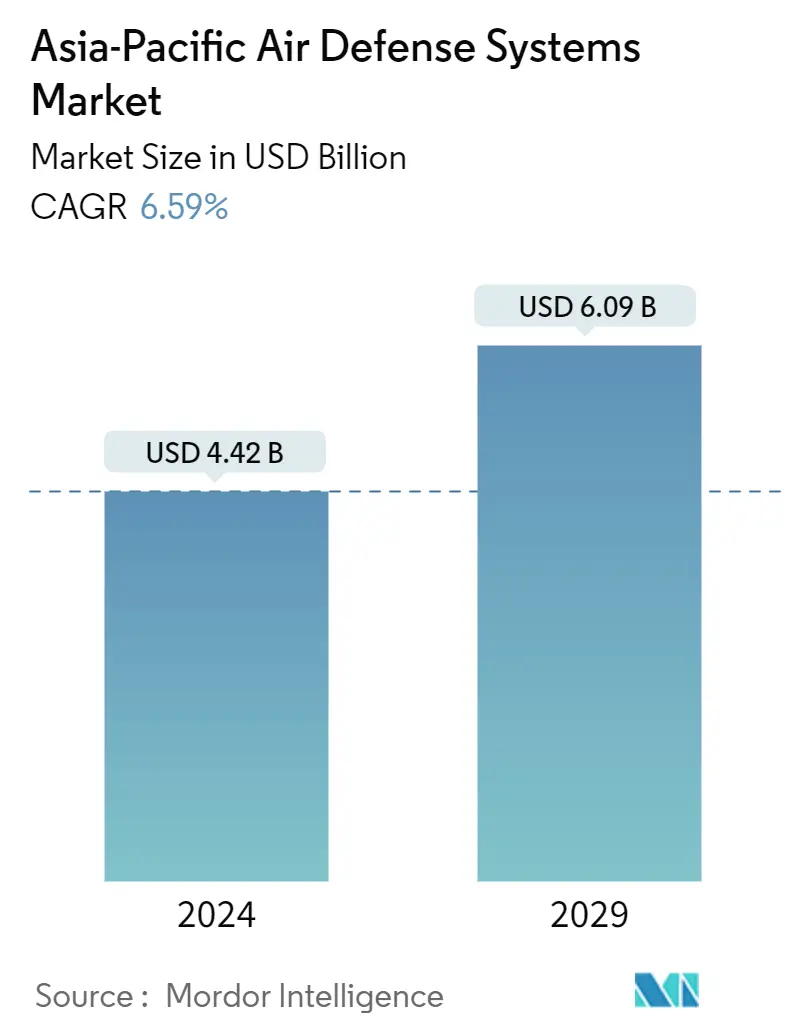
| Study Period | 2019-2029 |
| Base Year For Estimation | 2023 |
| Market Size (2024) | USD 4.42 Billion |
| Market Size (2029) | USD 6.09 Billion |
| CAGR (2024 - 2029) | 6.59 % |
| Market Concentration | Medium |
Major Players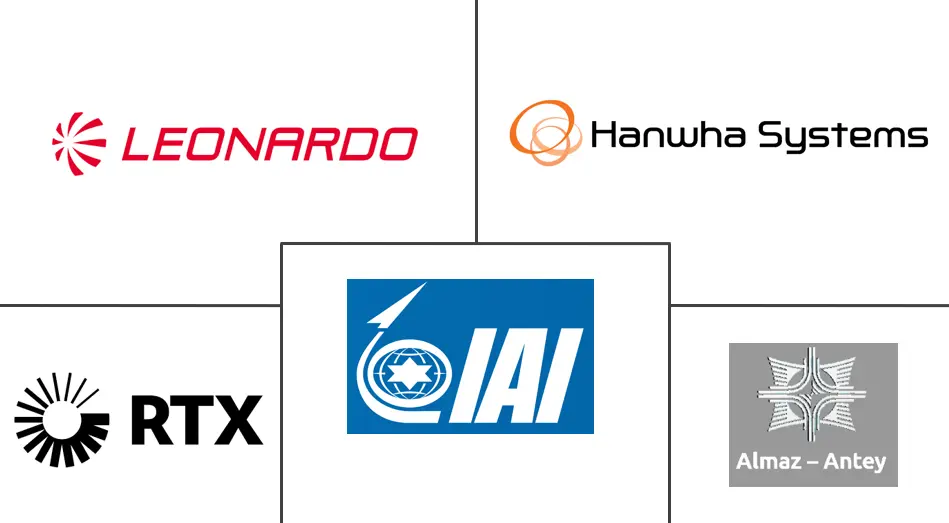
*Disclaimer: Major Players sorted in no particular order |
Asia-Pacific Air Defense Systems Market Analysis
The Asia-Pacific Air Defense Systems Market size is estimated at USD 4.42 billion in 2024, and is expected to reach USD 6.09 billion by 2029, growing at a CAGR of 6.59% during the forecast period (2024-2029).
The nature of air-based warfare has changed in recent years with the advent of more lethal, agile, and untraceable threats having autonomous capabilities. As threats increase, various countries across the globe are compelled to safeguard their territories from potential adversaries at any cost, due to which the emphasis on enhancing air defense capabilities has increased. The increasing geopolitical conflicts and border tensions between the neighboring countries in the region are forcing them to increase their military expenditure. This increase in military expenditure is propelling investments into air defense systems, which is generating demand for the air defense systems market in the Asia-Pacific region.
With advancements in technology, such as the development of advanced threats like hypersonic missiles, there is a growing need for better air defense systems. Due to this growing requirement, companies are developing advanced threat detection systems and countermeasures systems to counter UAVs, aircraft, missiles and rockets, artillery, and mortar threats. However, the inherently high R&D costs and the longer development cycle restrain the growth of the market studied as they expose the market players to global macro-economic uncertainties.
Asia-Pacific Air Defense Systems Market Trends
Land Segment to Witness Highest Growth During the Forecast Period
The land segment currently dominates the market studied and is expected to continue its dominance in the market during the forecast period. The demand for this segment is driven by the rising defense expenditures of major countries such as China, India, Japan, and South Korea. For instance, in 2022, China, India, Japan, South Korea, and Australia alone accounted for 88% of the region’s total defense spending. With these rising defense expenditures, these major countries and other countries in the region are increasing their defense capabilities to counter a wide range of threats like missiles (ballistic and cruise), aircraft, UAVs, rockets, artillery, and mortars. For instance, in November 2023, India announced that it was procuring a batch of Igla-S hand-held anti-aircraft missiles from Russia to bolster the army's combat capability. The Igla is a man-portable air defense system (MANPADS) that can be used to bring down enemy aircraft and helicopters.
Various countries in the region are in the phase of developing indigenously made advanced land-based air defense systems to counter geopolitical threats from various neighboring countries. For instance, Taiwan announced that it had entered mass production of the cutting-edge TC-2 air defense system in November 2023. This TC-2 is a short-to-medium-range defense system. The country’s army plans to receive 246 Sky Sword II air defense missiles. These TC-2s are designed as a land-based system to counter China’s fixed- and rotary-wing aircraft, drones, and cruise missiles. Overall, similar investments from various countries for the protection of their land borders are expected to propel the growth of the market studied during the forecast period.
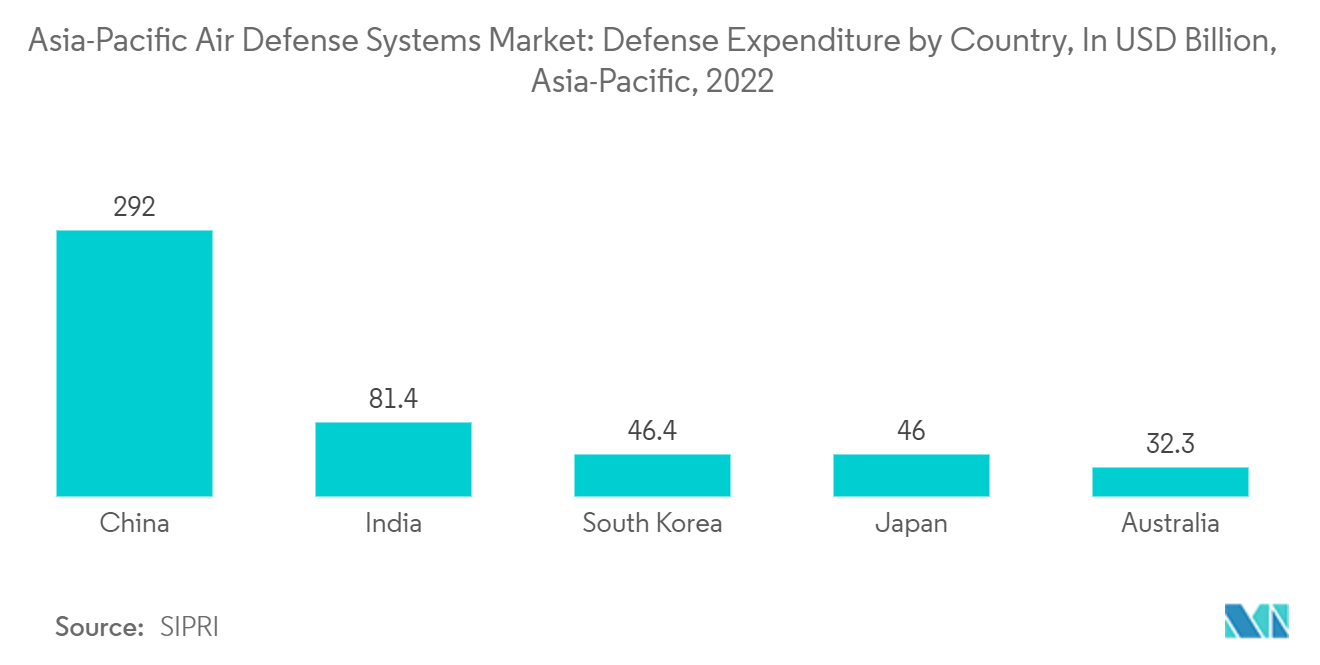
China is Expected to Witness the Highest CAGR During the Forecast Period
China is expected to witness the highest growth in the air defense market during the forecast period. The growing military expenditure of the country, fueled by geopolitical tensions and border disputes between the country and its neighboring countries, is driving investments in the procurement of advanced air defense systems. The country is the highest defense spender in the Asia-Pacific region, with military spending of USD 292 billion in 2022, a growth of 2% compared to military spending in 2021. China’s current military spending priorities follow the guiding principles set out in the 14th Five-Year Plan (2021–2025). With this mass defense spending, the country is developing advanced weapon systems, such as high-energy laser weapons to intercept aerial targets.
For instance, in August 2023, researchers from the National University of Defense Technology announced that it is in the phase of developing a laser weapon that can be fired indefinitely. If these high-powered laser weapons are developed fully, they might have the potential to be a game-changing technology in advanced warfare, as they could shoot targets such as drones, missiles, and small aircraft at nearly the speed of light at lower costs than interceptor missiles. In addition to this, China South Industries Group Corporation (CSGC) and China North Industries Group Corporation announced that they had developed short-range air-defense systems named Type 625E AA Gun Missile Integrated Weapon System to detect low-flying aircraft such as drones in November 2022. Such developments are anticipated to bolster the growth of the market studied.
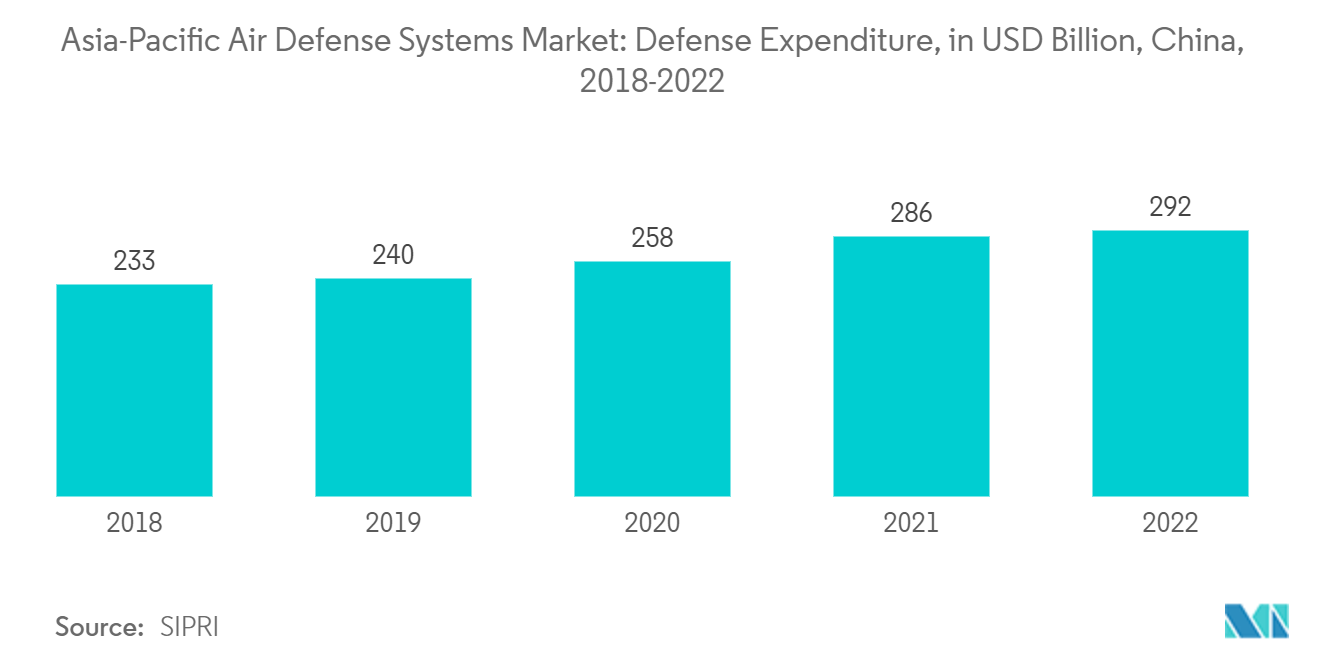
Asia-Pacific Air Defense Systems Industry Overview
The Asia-Pacific air defense systems market is semi-consolidated, with local as well as international players providing various types of air defense systems. Some of the prominent players in the Asia-Pacific air defense systems market are Almaz-Antey Corp., IAI, RTX Corporation, Leonardo SpA, and Hanwha Systems. The market is dominated equally by international and regional air defense system manufacturers.
The market share of regional players is expected to increase in the coming years due to increased investments from governments to support local manufacturing. For instance, in India, under the Indian Ballistic Missile Defense Program, the Defence Research and Development Organization (DRDO) is indigenously developing a multi-layered ballistic missile defense system against incoming threats. To increase their presence and share in the market, the companies are also investing heavily in research and development of advanced air defense systems with better detection and countermeasure systems.
Asia-Pacific Air Defense Systems Market Leaders
-
Leonardo S.p.A.
-
RTX Corporation
-
Hanwha Systems
-
IAI
-
Almaz-Antey Corp.
*Disclaimer: Major Players sorted in no particular order
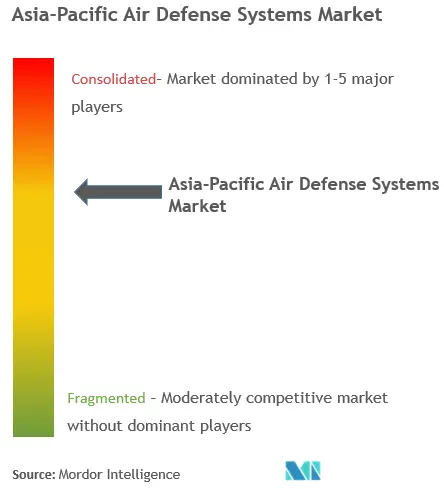
Asia-Pacific Air Defense Systems Market News
March 2023: Mitsubishi Heavy Industries (MHI) and Kawasaki Heavy Industries (KHI) unveiled the prototypes of their respective laser systems to shoot down incoming hostile unmanned aerial vehicles (UAVs) at the DSEI Japan 2023 show.
February 2023: India’s DRDO announced that it had developed a very short-range air-defense system (VSHORADS), missiles, and a man-portable air defense system (MANPADS). The DRDO also mentioned that it had commenced the testing of this weapon system.
Asia-Pacific Air Defense Systems Market Report - Table of Contents
1. INTRODUCTION
- 1.1 Study Assumptions and Market Definition
- 1.2 Scope of the Study
2. RESEARCH METHODOLOGY
3. EXECUTIVE SUMMARY
4. MARKET DYNAMICS
- 4.1 Market Overview
- 4.2 Market Drivers
- 4.3 Market Restraints
-
4.4 Porter's Five Forces Analysis
- 4.4.1 Threat of New Entrants
- 4.4.2 Bargaining Power of Buyers/Consumers
- 4.4.3 Bargaining Power of Suppliers
- 4.4.4 Threat of Substitute Products
- 4.4.5 Intensity of Competitive Rivalry
5. MARKET SEGMENTATION
-
5.1 Platform
- 5.1.1 Land-based
- 5.1.2 Air-based
- 5.1.3 Sea-based
-
5.2 Range
- 5.2.1 Long-range
- 5.2.2 Medium-range
- 5.2.3 Short-range
-
5.3 Geography
- 5.3.1 China
- 5.3.2 India
- 5.3.3 Japan
- 5.3.4 South Korea
- 5.3.5 Australia
- 5.3.6 Rest of Asia-Pacific
6. COMPETITIVE LANDSCAPE
-
6.1 Company Profiles
- 6.1.1 Almaz-Antey Corp.
- 6.1.2 IAI
- 6.1.3 RTX Corporation
- 6.1.4 Leonardo SpA
- 6.1.5 Hanwha Systems
- 6.1.6 Rafael Advanced Defense Systems Ltd
- 6.1.7 Defense Research and Development Organization
- 6.1.8 Lockheed Martin Corporation
- 6.1.9 BAE Systems PLC
- 6.1.10 MBDA
- 6.1.11 Northrop Grumman Corporation
- *List Not Exhaustive
7. MARKET OPPORTUNITIES AND FUTURE TRENDS
** Subject To AvailablityAsia-Pacific Air Defense Systems Industry Segmentation
Air defense systems include all the radars and interceptors used by air, land, and sea platforms to detect and destroy incoming threats of missiles (ballistic and cruise), aircraft, UAVs, rockets, artillery, and mortars. MANPADs, pedestal-mounted MANPADs, and remote weapon stations that can defend against incoming airborne threats, automatically tracking, targeting, and firing, are also included in the study.
The Asia-Pacific air defense systems market is segmented by platform, range, and geography. By platform, the market is segmented into land-based, air-based, and sea-based. By range, the market is segmented into long-range, medium-range, and short-range. The report also offers the market size and forecasts for five countries across the region. The report offers the market size in value terms in USD for all the abovementioned segments
| Platform | Land-based |
| Air-based | |
| Sea-based | |
| Range | Long-range |
| Medium-range | |
| Short-range | |
| Geography | China |
| India | |
| Japan | |
| South Korea | |
| Australia | |
| Rest of Asia-Pacific |
Asia-Pacific Air Defense Systems Market Research FAQs
How big is the Asia-Pacific Air Defense Systems Market?
The Asia-Pacific Air Defense Systems Market size is expected to reach USD 4.42 billion in 2024 and grow at a CAGR of 6.59% to reach USD 6.09 billion by 2029.
What is the current Asia-Pacific Air Defense Systems Market size?
In 2024, the Asia-Pacific Air Defense Systems Market size is expected to reach USD 4.42 billion.
Who are the key players in Asia-Pacific Air Defense Systems Market?
Leonardo S.p.A., RTX Corporation, Hanwha Systems, IAI and Almaz-Antey Corp. are the major companies operating in the Asia-Pacific Air Defense Systems Market.
What years does this Asia-Pacific Air Defense Systems Market cover, and what was the market size in 2023?
In 2023, the Asia-Pacific Air Defense Systems Market size was estimated at USD 4.13 billion. The report covers the Asia-Pacific Air Defense Systems Market historical market size for years: 2019, 2020, 2021, 2022 and 2023. The report also forecasts the Asia-Pacific Air Defense Systems Market size for years: 2024, 2025, 2026, 2027, 2028 and 2029.
Asia-Pacific Air Defense Systems Industry Report
Statistics for the 2024 Asia-Pacific Air Defense Systems market share, size and revenue growth rate, created by Mordor Intelligence™ Industry Reports. Asia-Pacific Air Defense Systems analysis includes a market forecast outlook for 2024 to 2029 and historical overview. Get a sample of this industry analysis as a free report PDF download.



